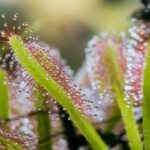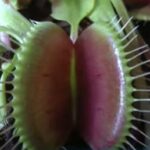As an Amazon Associate, this site earns commissions from qualifying purchases. For more details, click here.
The Drosera rotundifolia, also known as the common or round leaved sundew, is native to many parts of the US, northern Europe and Japan. Caring for D rotundifolia is not as difficult as you might think. In fact even a beginner can do it with proper planning.
Drosera rotundifolia can handle temperatures up to 95 F but goes dormant when it drops to 60 degrees. These plants require at least 6-8 hours of light and soil consisting of equal parts peat moss and sand.
Drosera Rotundifolia Care Sheet
| Soil | 1:1 peat moss and sand, keep soil moist |
| Water | Distilled, purified or rainwater |
| Light | 6 hours minimum sunlight, indoor grow lights are fine |
| Food | Bugs, freeze dried meal worms, fish food |
| Temperature | 65-95 F (18-35 C) |
| Humidity | 50-70% |
| Dormancy | Yes, 3-5 months |
| Propagation | Leaf pulling, root cutting seeds, division |
Soil and Pot Requirements
Drosera rotundifolia will only grow in nutrient free soil. You can combine 1:1 silica sand and peat moss or 100% dead or live long sphagnum. A soil mix consisting of mainly long sphagnum and bits of sand and peat is also effective.
The 1:1 ratio is the standard but you can try 2:1, 3:1 or even all long sphagnum. But for beginners it is better to mix equal parts. You can try other mixing ratios when you have more experience growing sundews.
Just like Cape sundews, long leaved sundews require constantly moist soil. These plants grow in moist conditions in nature like bogs so moisture is crucial.
A 3 inch pot is ideal. You can use deeper containers but it is not necessary. The deeper the pot the more water you have to use to keep the soil damp. Plant your D. rotundifolia in a 3 inch pot and it should be sufficient.
Watering
The best way to water round leaved sundews is to use the tray method. Set the pot inside it. Pour an inch of water in the tray. The hole in the pot will allow the water to seep into the roots and nourish the plant. Replenish the tray with water as needed.
Never use tap water for common sundews or any drosera. Tap water is laden with minerals that are harmful to the plant and could seriously affect its growth. Instead use distilled or purified water. Reverse osmosis is also safe for D. rotundifolia.
Light Requirements
Whether you grow sundews outdoors or indoors, light is a must. Six hours is the minimum light requirement for round leaved sundews. The more light the plant gets, the healthier it will be.
The ideal scenario is 8 hours of light every day. If your D. rotundifolia is outdoors, pick the sunniest location in your garden. If the plant will be indoors, set the pot on a south facing window so it can absorb as much light as possible.
Artificial means can be used to supplement natural light. If you only get 5-6 hours of light a day, a 40W fluorescent light is an acceptable solution. Place the fixture close to the plant (n more than a foot away) and leave it on for 14 hours a day. We suggest Esbaybulbs Lights since it is effective for growing plants indoors.
Temperature
The safe temperature range to grow Drosera rotundifolia is 65-95 F. When it drops to 60 degrees and below the plant enters dormancy. Anything above 95 F and there is a risk of sunburn.
While sundews need light to live, too much heat could be fatal. Prolonged exposure to intense heat can dry the roots and cause death.
One of the signs of sunburned drosera is lack of dew or mucilage. This sticky stuff is made partly of water, so naturally it evaporates under heat.
Sundews cannot eat without mucilage. And without the nutrients that insects and other animals provide, drosera becomes susceptible to bacterial diseases.
Signs that your is having trouble with high temperature are:
- Very little or no dew on the leaves
- The leaves are dry, brownish or black
- The plant feels hot to touch
- The soil is drying up
Provide cover for your D. rotundifolia if you notice these symptoms. The sooner you give it shade the faster the plant can recover. But as long as the temperature does not go above 95 F sunburn will not be a problem.
Humidity
Round leaved sundews prefer a humidity range between 50-70%. High humidity helps sundews grow faster especially if there is plenty of light.
In nature, these plants grow in sunny wetlands, fens, marshes and bogs. These are naturally humid and expose the sundew to light. This is the type of setting you should try to emulate outdoors or indoors.
You do not need to create a bog at home, just keep the humidity and temperature within the recommended range. This is where the tray water method comes into play. By sitting the pot in water, it increases the humidity around the drosera.
As long as there is water in the tray the air around it stays humid. This is conducive to sundew growth especially during spring and the hotter months. If you want your sundew to receive light but worried about the heat, sit the plant in water. It will keep the plant cool.
Feeding
If you want sundews to grow fast, feed it regularly. Round leaved sundews need to eat 2-4 times a month or on a weekly basis. Well fed sundews grow faster than those deprived of nutrients. They also live longer and are healthier.
Keep food particles small to avoid burning the tentacles and leaves. If you feed live prey its tentacles will move quickly to trap it. However these plants also feed on dead bugs. Place the food on the dew and wait for the tentacle to go over it.
If you are growing from seeds, wait until there are a few leaves and dew before feeding. As the plant grows, manual feeding becomes unnecessary. You only need to manually feed a round leaved sundew if it is indoors and unable to get food on its own.
If you do not want to worry about feeding, leave your sundew outdoors and it will have no problems finding nutrients from flying and crawling insects. If you would rather have them indoors, you can just as easily buy Hatortempt mealworms for their nutrition. These are as nutritious as insects and as effective.
Dormancy
Drosera rotundifolia goes dormant for 3-5 months. In some cases this may last 6 months. Some D. rotundifolia forms like the “Charles Darwin” do not go through this, but majority of them do.
Most round leaved sundews can handle winter freezing. As stated the plant goes dormant at 60 degrees and lower, but this will not kill it. The plant sheds its leaves and may look dead. But it is still alive and just gone dormant.
If this occurs you have to wait several months before the sundew blooms again. You can even leave the plant outdoors. Just make sure to use a large container and and it is topped with sphagnum moss.
Now if you are worried about the plant dying, do some leaf cutting while it is healthy. This way you can start over with the same plant if it does not recover from dormancy.
Propagation
There are four ways to propagate round leaved sundews: seeds, leaf cuttings, division and root cuttings.
D. rotundifolia roots clump so it is fairly easy to pull it apart from the base. You do need to be careful not to break the whole root. This is an effective propagation method but does require a lot of work.
In contrast leaf cutting is as easy as it sounds. You literally just have to cut some healthy leaves and place it on a tray of water. A plantlet will sprout up and has to be fed. Regular feeding will lead to faster growth.
D. rotundifolia seeds do not require cold stratification so planting and cultivating is easy. A the seeds produce leaves, keep an eye when dew appears. That is the sign the plant can now start to feed on insects.
Conclusion
Caring for D. rotundifolia is not without its challenges, but nothing you cannot overcome. It is one of the most beautiful sundews, and well fed seeds flower within seven months. Combined with its colorful leaves and dew, it makes the plant even more attractive.

My fascination with carnivorous plants began many, many years ago with Venus Fly Traps. Now I am more than happy to impart what I know with other enthusiasts and those who are curious about meat eating plants.



